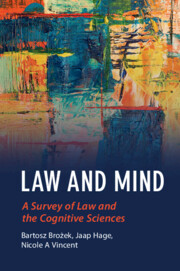Book contents
- Law and Mind
- Law and the Cognitive Sciences
- Law and Mind
- Copyright page
- Contents
- Figures
- Contributors
- Acknowledgements
- 1 Introduction
- I Metatheory and Methodology
- II Ontology and Epistemology
- III Legal Doctrine and Cognitive Sciences
- IV Evidence
- 17 Implications of Neurotechnology: Brain Recording and Intervention
- 18 Neuroimaging Evidence in US Courts
- 19 Neuroscientific Evidence in Context
- 20 Some Issues in Interpreting Neuroscientific Evidence
- 21 Explanation-Based Approaches to Reasoning about Evidence and Proof in Criminal Trials
- V Dissenting Opinions
- References
20 - Some Issues in Interpreting Neuroscientific Evidence
from IV - Evidence
Published online by Cambridge University Press: 21 April 2021
- Law and Mind
- Law and the Cognitive Sciences
- Law and Mind
- Copyright page
- Contents
- Figures
- Contributors
- Acknowledgements
- 1 Introduction
- I Metatheory and Methodology
- II Ontology and Epistemology
- III Legal Doctrine and Cognitive Sciences
- IV Evidence
- 17 Implications of Neurotechnology: Brain Recording and Intervention
- 18 Neuroimaging Evidence in US Courts
- 19 Neuroscientific Evidence in Context
- 20 Some Issues in Interpreting Neuroscientific Evidence
- 21 Explanation-Based Approaches to Reasoning about Evidence and Proof in Criminal Trials
- V Dissenting Opinions
- References
Summary
This paper comments on Jane Moriarty’s chapter on neuroimaging evidence in the US courts by presenting a couple of inferential pitfalls one may encounter in interpreting neuroscientific evidence in the context of law and trial.
First, a general issue of heterogeneity of neuroscientific data (structural vs. functional, individual vs. group) is discussed, which gives the background for revealing other problems. Secondly, an example of the multiplicity (cascade) of assumptions and inferences entangled in interpreting a simple CT scan in the legal context is presented. Finally, some specific inferential pitfalls are described (primarily the reverse inference issue, the group-to-individual problem, and the lingua franca problem) and a few more are briefly mentioned.
The paper suggests that, for now, the possibilities that neuroscience offers fact-finders are quite modest, and interpreting neuroscientific evidence in the context of law is a difficult business.
- Type
- Chapter
- Information
- Law and MindA Survey of Law and the Cognitive Sciences, pp. 421 - 430Publisher: Cambridge University PressPrint publication year: 2021



